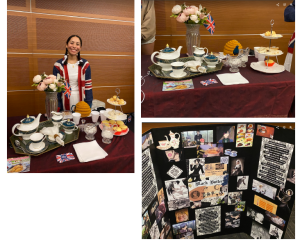4 Category 4: Multimodal
Gimena Alejandra Cante Sifuentes; Jadyn Hayes; and Chloe Long
A shot-by-shot analysis of the cinematic techniques employed in the scene “This is Your Home” in the 1998 film The Prince of Egypt by DreamWorks Animation
Awarded to Gimena Alejandra Cante Sifuentes for work submitted in Summer 2024 to Dr. Aleka Blackwell in ENGL 1010: Expository Writing
Please access Gimena’s multimodal project by clicking on the following Google Drive link below:
https://drive.google.com/file/d/1mu3fgSs9FqTLiaxD8fmmlWa_n7jetsTo/view?usp=sharing
Black Butler: A Gothic and Horror Tea Time
Awarded to Jadyn Hayes for work submitted in Spring 2024 to Dr. Bridget Donnelly Blackwell in ENGL 2020: Themes in Literature and Culture
My project, “Black Butler: A Gothic and Horror Tea Time”, was born out of a blend of my love for anime and a fascination with history, particularly within the Gothic and Horror genre. The intention behind this project was not just to be creative but to also delve into the rich themes presented throughout Black Butler – a 2008 Japanese anime show that was set in, London during
the Victorian Era, and follows the life and experiences of Ciel, a twelve-year-old boy who sold his soul to his devil of a butler to enact revenge on those who killed his family. To achieve this, he takes up the mantle of Earl Phantomhive and “Queen’s Watchdog”, facing mysteries and dangers along the way. Through this reflection, I aim to share the inspirations behind my project, the significant decisions I made, and how it all ties into our course materials and discussion on
the Gothic and Horror genre.
The spark for my project was set ablaze from my deep admiration for anime, leading me to discover Black Butler – a truly captivating series that weaves Gothic and horror elements into the backdrop of nineteenth-century London, otherwise known as the Victorian era. This era gets its name from, you guessed it, Queen Victoria herself! The show follows Ciel Phantomhive, a
young Earl seeking vengeance for the murder of his parents with the aid of his mysterious demon butler, Sebastian Michaelis. I was drawn into Black Butler, through the show’s atmospheric music, which beautifully captured the essence of Victorian London, and its attention to historical details blended with supernatural narratives. The characters in the anime also contributed significantly to its Gothic and Horror identity. Demon dogs and butlers (like Sebastian), encounters with angels versus demons, and even guardians of the underworld, embody classic supernatural tropes. Other characters, such as doll-makers and masters, serial killers, individuals with super-human strengths, and blood-cult leaders, deepen the show’s overall theme and vibe.
This diverse cast creates an exquisitely haunting atmosphere filled with gut-wrenching mystery, suspense, and intrigue, also reflecting broader societal anxieties of the Victorian era. Even moreso, the shows usage of secondary characters such as the manner’s servants, Bard, Mey-Rin, and Finnian, encapsulate the Victorian social class system, how lower-class individual were
treated, how they were seen by those of the upper class, and they were an extremely integral part of Victorian society – they were the literal beating heart of society. Furthermore, the overall themes of death, crime, social upheavals, and demonic contracts encapsulated the very essence of the Gothic and horror genre.
For my creative project, I chose to recreate Ciel’s Afternoon tea table! I wanted the project to not only be rooted in the anime itself but also with historical accuracy and thematic spice. The Victorian era, known for its eerie ambiance and fascination with the supernatural, provided the perfect setting for this project. The Victorian period in itself can be described as an incredibly
gothic setting, with its gloomy atmosphere (it was as if death was always knocking on people’s doors), architecture, scientific innovations, as well as supernatural exploration like talking with ghosts and trying to get into contact with the dead. Additionally, Black Butler highlights many key events in London during the 19th century, mentioning real-life events, figures, social upheavals, and tragedies that occurred during this tumultuous era. For example, there are multiple episodes in the first season (Season 1 episodes 4-6) where the legendary serial killer, Jack the Ripper, is mentioned, alongside the mentioning of Britain’s colonial and imperial impact on India (Season 1 episodes 13-15), and even class warfare in London society. By carefully
selecting Victorian china, a crimson tablecloth, and authentic tea accessories, I aimed to capture not only the show’s aesthetic but also the opulence and refinement associated with Victorian British tea culture. As Ciel is an Earl, a rank of English nobility, he participated in Afternoon tea– a British tradition of sitting down for an afternoon treat of tea, sandwiches, scones, and cake
around 4 pm. Tea was such an integral part of Ciel’s days, having tea for a midday snack as well as for breakfast. For high nobility during the Victorian era, tea was traditionally served on low, comfortable, parlor chairs or relaxing in the garden. The symbolism of tea within the series, often linked with ideas of wealth and social identity, further solidified the choice to recreate this aspect of Ciel’s daily life. I wanted to express this sense of a refined, gothic, opulence, with a tea set for one, as Ciel was typically served his tea alone rather than with a group of people. I had one large teapot, 2 small saucers, one teacup, silverware, a sugar bowl, and a creamer. I had it centered on a small green tea tray alongside a 3 tier cake stand that incorporated the typical Victorian cake allotment; a Victoria sponge, cucumber sandwiches, battenbergs, and creme puffs. Of course, it wouldn’t be an accurate tea time reenactment without some tea, so I served a simple black tea with milk and sugar cubes. This project was so impactful for me, as it served as a bridge between anime fandom and historical appreciation, allowing me to blend my passion for both realms! It was so amazing to witness fellow anime nerds connect with the Victorian era in Black Butler,
revealing how popular culture can also spark an interest in historical narratives.
In our course discussions on the Gothic and horror genre, Black Butler embodies several key tropes and themes. The Victorian setting, with its ominous mansions and themes of mystery and death, aligns perfectly with classic Gothic narratives, much like Mexican Gothic and Carmilla. The show’s exploration of supernatural bodies and the paranormal mirrors the fascination with the unknown prevalent in Gothic literature. In the anime, we see obvious mentions of ghosts, spirits, and demons. One notable mention has to be the episode where Ciel tries to take a picture of Sebastian, his demon butler, and it was told that if someone took a picture when developed, the picture would reveal what is most precious to the picture’s subject that is deceased or not of this world (Season 1, Episode 9). During the Victorian era, photography was seen and used as a
way to get in contact with ghosts or dead loved ones. Additionally, the inclusion of historical figures like Jack the Ripper highlights the blending of real-world events with fictional narratives, a common trope in the Gothic and Horror genres. Tea symbolism within the series reflects broader societal ideals of the Victorian period, where tea became equal with statues and
refinement. The ritual of Afternoon tea, originally (and also supposedly, this can be debated) introduced by Anna Russell, Duchess of Bedford (who was also a close friend of Queen Victoria), evolved into a display of wealth and sophistication among the upper class. By recreating Ciel’s tea time, I aimed to highlight the material culture associated with Victorian tea
traditions and its overall significance in defining social identities, which was also a huge deal for Victorians. Moreover, the project underscores the enduring legacy of Victorian tea culture, which continues to influence modern-day tea customs in the UK (United Kingdom). The evolution of tea-drinking practices also reflects broader societal transformations, from the acquiring of Asian-inspired tea sets, like china, to the prominence of European and Western influences in tea
accessories during the mid-nineteenth century.
In conclusion, “Black Butler: A Gothic and Horror Tea Time” really represents a merging of creative inspiration and historical curiosity. Through this project, I was able to give acknowledgement to the captivating allure of Black Butler’s gothic themes while also engaging in a much deeper exploration of Victorian society and its impact on material culture. This project
showcases the transformative power of popular media in highlighting historical narratives and making more integrated connections within academia and beyond. It is also a testament to the enduring fascination with Gothic and Horror themes and their lasting appeal in twenty-first-century culture.
Celebration of Student Writing Presentation Pictures:

Works Cited
1. Bastion. “Ciel Phantomhive Tea Time. | Black Butler Amino.” Ciel Phantomhive Tea Time., Amino, 30 Mar. 2018,
aminoapps.com/c/black-butler/page/blog/ciel-phantomhive-tea-time/g0gb_Pk8u6uq0XM
bDnp0xogKDNkk5XQED42.
2. Fabry, Merrill. “Why Is Teatime in the Afternoon? Now You Know.” Time, Time, 2 Mar. 2017, time.com/4640082/teatime-history/.
3. Fromer, Julie E. A Necessary Luxury : Tea in Victorian England. Ohio University Press, 2008. EBSCOhost,
search.ebscohost.com/login.aspx?direct=true&db=nlebk&AN=818142&site=eds-live&sc
ope=site.
4. Fromer, Julie E. “‘Deeply Indebted to the Tea-Plant’: Representations of English National Identity in Victorian Histories of Tea.” Victorian Literature and Culture, vol. 36, no. 2, 2008, pp. 531–47. JSTOR, http://www.jstor.org/stable/40347203. Accessed 3 Apr. 2024.
5. Formichella, Janice. “A Brief History of Victorian Afternoon Tea.” Recollections Blog, 20 Feb. 2023, recollections.biz/blog/a-brief-history-of-victorian-afternoon-tea/.
6. Granger, Ruby. “I Hosted an Authentic Victorian Tea Party.” YouTube, YouTube, 11 July 2021, www.youtube.com/watch?v=ZjLsbfCllqg.
7. Hui, Christy. “High Tea vs Afternoon Tea: A Complete Guide: 9 Dragons Tea.” 9 Dragons Tea – The Drink That Changed The World, 12 Jan. 2024, 9dragonstea.com/blog/high-tea-vs-afternoon-tea/.
8. “List of Black Butler Episodes.” Wikipedia, Wikimedia Foundation, 7 May 2024,
en.wikipedia.org/wiki/List_of_Black_Butler_episodes#Season_1_(2008%E2%80%9309)
9. Marks, Tasha. “The Tea-Rific History of Victorian Afternoon Tea.” The British Museum, 14 Aug. 2020, www.britishmuseum.org/blog/tea-rific-history-victorian-afternoon-tea.
10. Miller, Max. “The Noble Origins of Afternoon Tea.” YouTube, YouTube, 2 Aug. 2022,
www.youtube.com/watch?v=hIKx0G4ghpA.
11. Olver, Lynne. The Food Timeline–Afternoon Tea & Tea Time, 3 Jan. 2015, www.foodtimeline.org/teatime.html.
12. Reynolds, Eileen. “Tea: A Literary Tour.” The New Yorker, The New Yorker, 10 Nov. 2010, www.newyorker.com/books/page-turner/tea-a-literary-tour.
13. Wakana, Sylvia. “Anime Eats: Gothic High Tea (Kuroshitsuji/Black Butler).” YouTube, YouTube, 27 July 2017, www.youtube.com/watch?v=Kr9Iwka7UbM.
14. Young, Paul. “A Necessary Luxury: Tea in Victorian England, by Julie E. Fromer.” Victorian Studies, vol. 52, no. 1, 2009, pp. 150–52. JSTOR, https://doi.org/10.2979/vic.2009.52.1.150. Accessed 3 Apr. 2024.
Black Butler Episodes and Time Stamps:
1. Season 1, Ep. 3 @ 22:47 (“His Butler, Omnipotent” Transliteration: “Sono Shitsuji, Bannō” (Japanese: その執事、万能) – How to prepare adequate tea, “a spoonful for each person and one for the pot. Finally, add half a pint of boiling water and let it steep until dark, ie. steeping of the tea).
2. Season 1, Ep. 4 @ 20:50 (“His Butler, Capricious” Transliteration: “Sono Shitsuji, Suikyō” (Japanese: その執事、酔狂) Script: “The demon serves and in exchange, the prey can never escape”).
3. Season 1, Ep. 9 ( “His Butler, Phantom Image” Transliteration: “Sono Shitsuji, Genzō” (Japanese: その執事、幻像)- Photography)
4. Season 1 Eps. 4-6 (“His Butler, Capricious, His Butler, Chance Encounter, and His Butler, At the Funeral – Jack the Ripper).
5. Season 1 Eps. 13-15 (“His Butler, Freeloader, His Butler, Supremely Talented, and His
Butler, Competing” – Impacts of British Colonialism and Imperialism).
Packaged and Processed: Taking Control of Eating Habits
Awarded to Chloe Long for work submitted in Spring 2024 to Melissa LaDuc in ENGL 1020: Research and Argumentative Writing
Please click on the link below to view Chloe’s multimodal research project:
Taking Control of Eating Habits (1)
Media Attributions
- Screenshot 2025-08-05 154233

